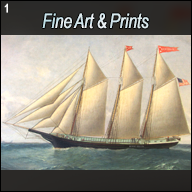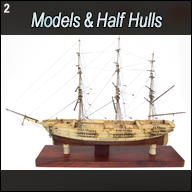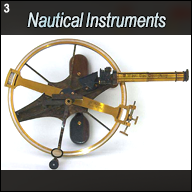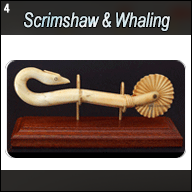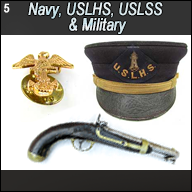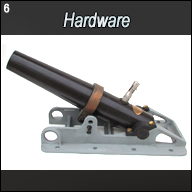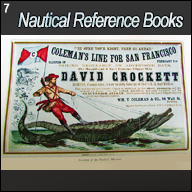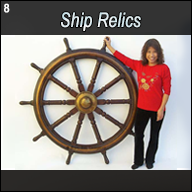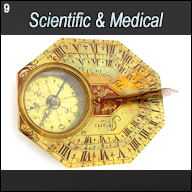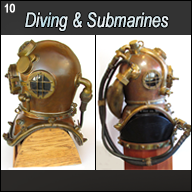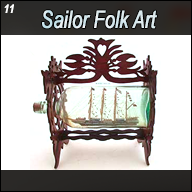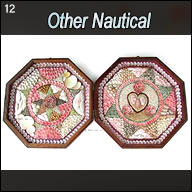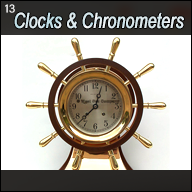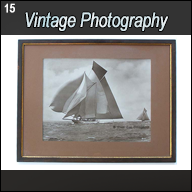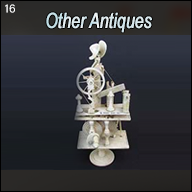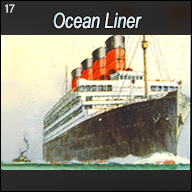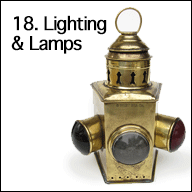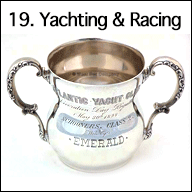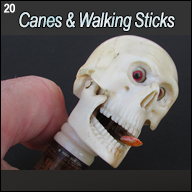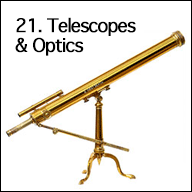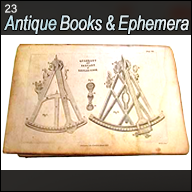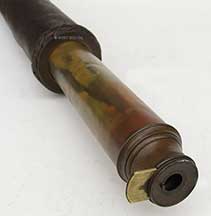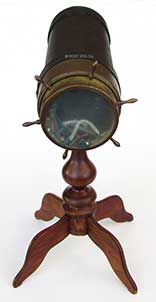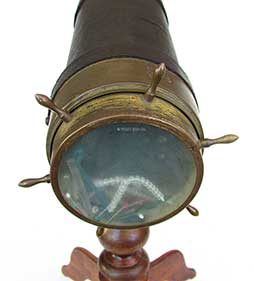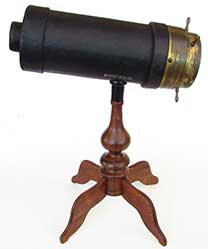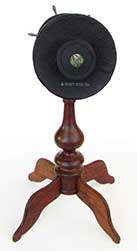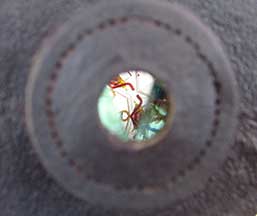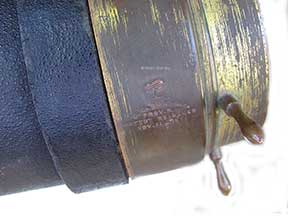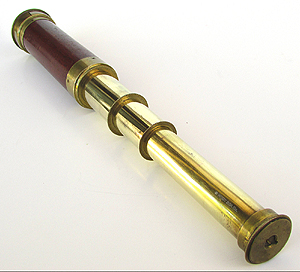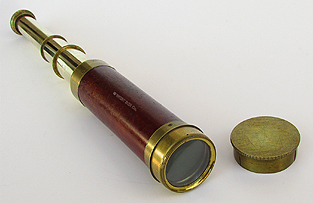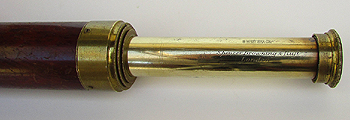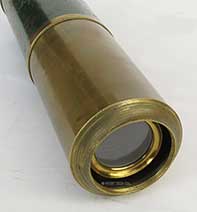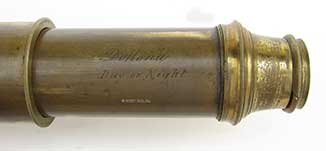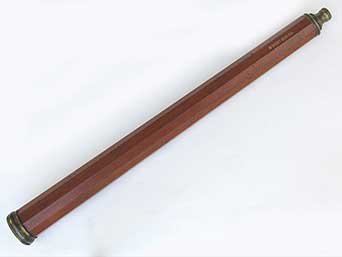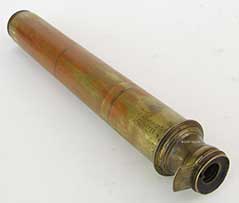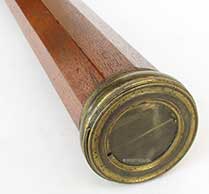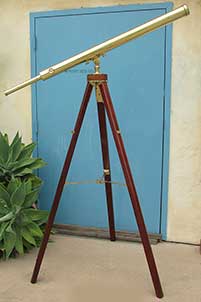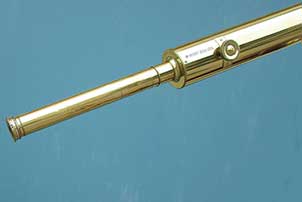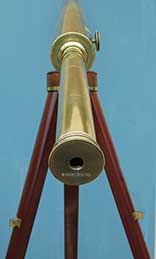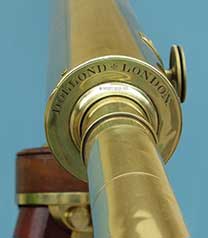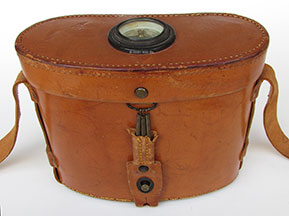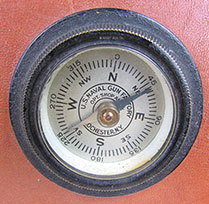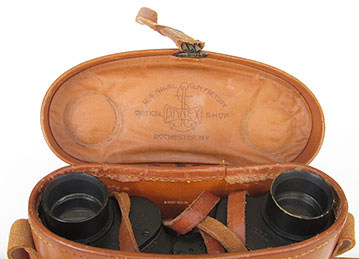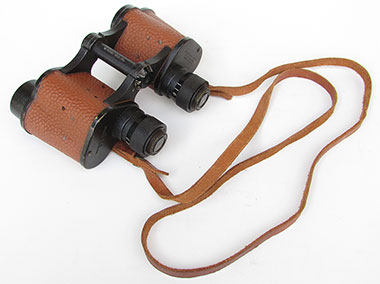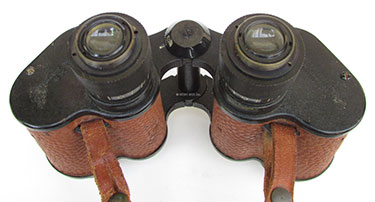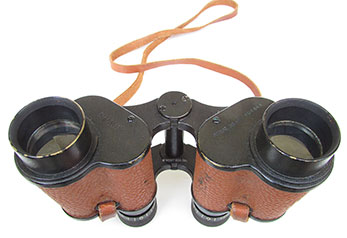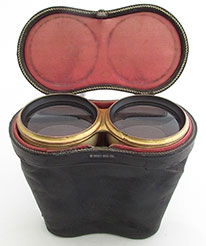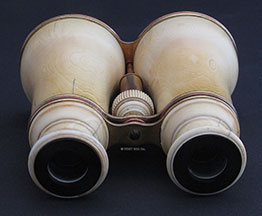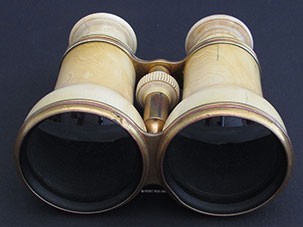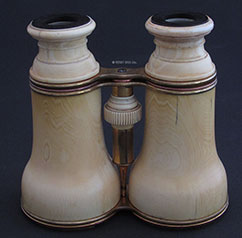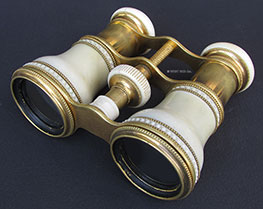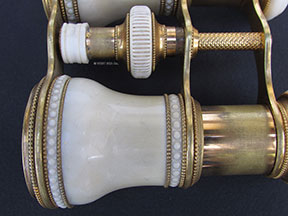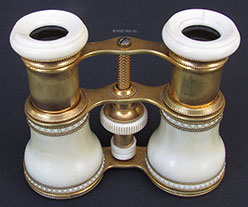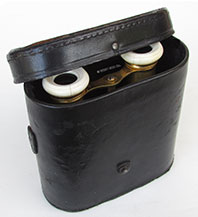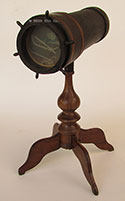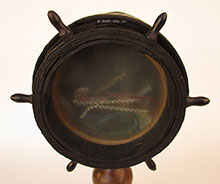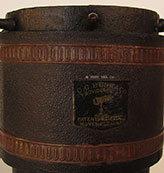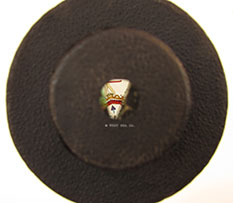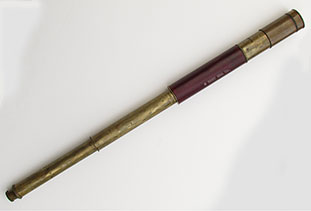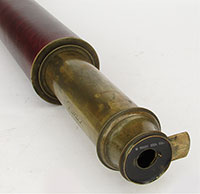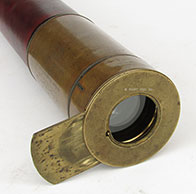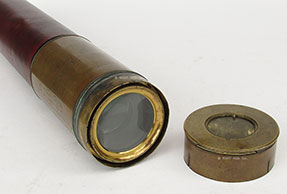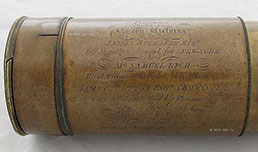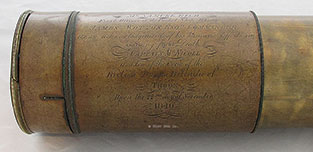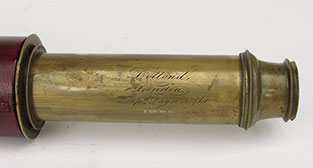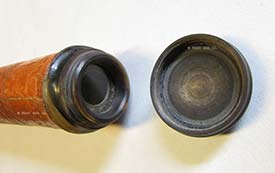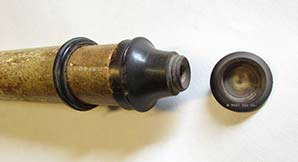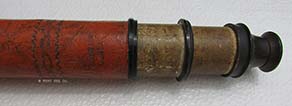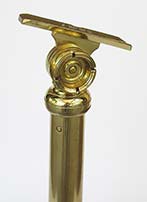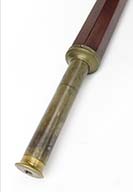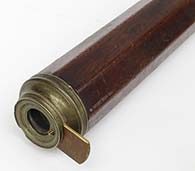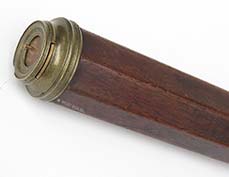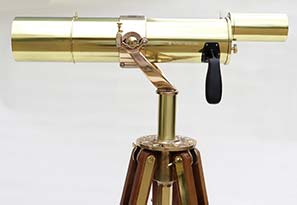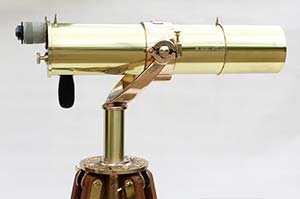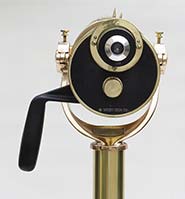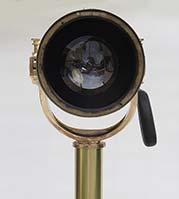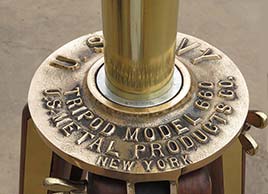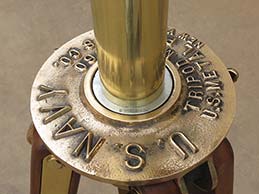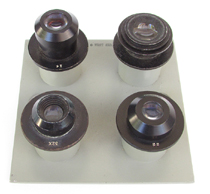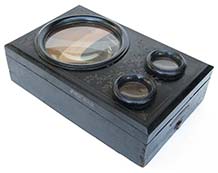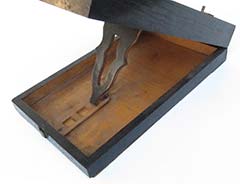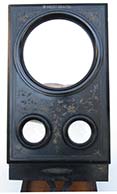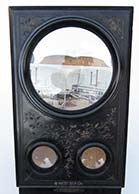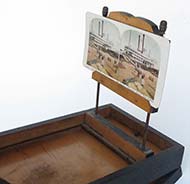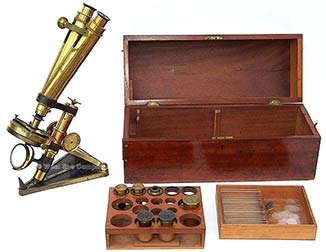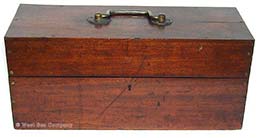21. Telescopes & Optics
Prices in U.S. Dollars are in GREEN
 |
21.62 EARLY CASED TELESCOPE. Extra nice, first quarter of the 1800’s hand-held 2-draw gentleman’s telescope of English manufacture. Although unsigned it embodies distinctive characteristics exhibited by telescopes produced by the elite English opticians dating from the 18th century onward. Perhaps the most telling feature is the objective lens housing which has the classic turned brass collar with sunken radius and sliding dust cover. These telling attributes were lacking in telescopes produced after 1830, no doubt because they were more expensive to produce and did not contribute to the telescope’s performance. This early example has a solid mahogany body and a very unusual, large brass objective housing. In it is a very thick 2-piece achromatic lens with early style sliding dust cover. The 2 brass draws are equally unusual. They house the standard 4 element lens erecting system. But the connection between the first and second draws is “hidden.” This means when the telescope is fully collapsed, it is much smaller in length. To those ends, the ocular has the 18th C. style sliding dust cover. Conveniently, it allows the telescope to fit its original leather carrying case in a shortened, space saving way. Overall condition is excellent in ALL respects. The telescope optics are perfect and produce a clear, highly magnified upright image free of chromatic distortion. The telescope measures 8 inches closed extending to 19 inches. Its stout oblong leather case measures 9 inches long by 2 ¼ inches wide at the widest. The fact that this telescope comes with its original leather case in such pristine, original condition is a scarce, very rarely seen addition. 429 |
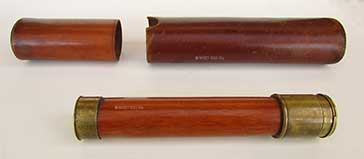 |
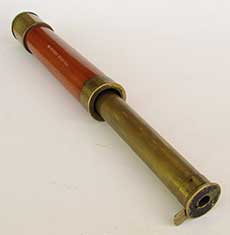 |
| components | ocular |
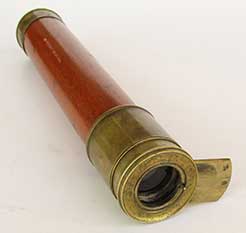 |
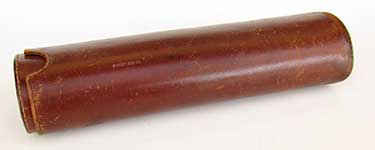 |
| objective | leather case |
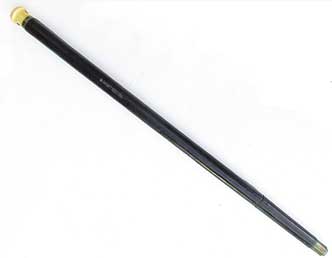 |
20.00/21.61 RARE TELESCOPE CANE. Amazing, very early 1800’s English gentleman’s walking stick with the most unusual dual function of being a long distance telescope! This ingenious device is all brass in its traditional black leather covering. It has a large turned ivory knob and brass ferrule. Both the knob and the ferrule are threaded. Unscrewing them reveals a genuine, tapered single draw telescope of the “spyglass” type. The draw on the ferrule end is engraved in fancy script with the makers “G. & W Proctor, London.” The doublet objective lens measures 1 1/8 inches in diameter. In combination with the classic 4 element lens system it provides a highly magnified upright image free of chromatic distortion. The telescope itself measures 25 ½ inches long closed and 31 inches extended to infinity. The lovely knob is 2 5/8 inches in diameter and 1 ½ inches tall. It is connected to a threaded brass band ¼ inch thick and 1 ¼ inches in diameter. Such a configuration, which required frequent opening and closing, is still in remarkable original condition. The fittings are tight, sturdy and fully functional. A true rarity, both as a telescope and a cane! 1095 George and William Proctor were listed as opticians in London from 1790 - 1830. (Gloria Clifton, “Directory of British Scientific Instrument Makers 1550 – 1851,” 1995, The National Maritime Museum, Philip Wilson Publishers, London.) |
 |
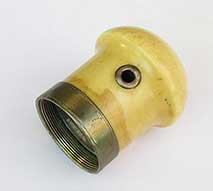 |
| components | knob |
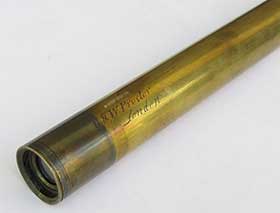 |
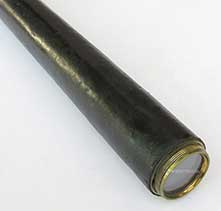 |
| ocular | objective |
 |
| maker |
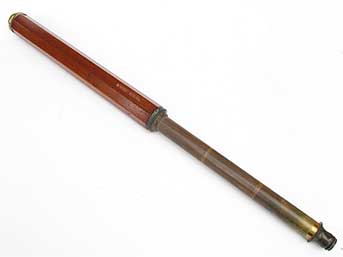 |
21.60 MINT 18th C. TELESCOPE. Remarkably well preserved Captain’s spyglass from the early days of sail. Of English manufacture, this 8-sided hand-held scope has a solid body carved from rich mahogany. The monochrome objective lens is a mere 5/8 inch in diameter, indicative of its early construction when glass blowing and lens making, free from occlusions, were in their infancy. This lovely artifact is in virtually pristine condition. The objective lens housing still retains its original bright lacquered surfaces and its sliding dust cover. The draw tube is of the early “nipple” form, complete with its sliding dust cover. Speaking to its age, the internal erecting system consists of 3 lenses instead of the more typical 4. Furthermore the individual lenses are held in place by threaded retainers rather than being rolled in place like later telescopes. As such the single draw tube actually consists of 3 threaded separate components. The telescope measures 14 inches long closed expanding to 23 ½ inches fully extended. It measures 1 ½ inches thick. Close to 300 years old if not older! Amazing. 1195 |
 |
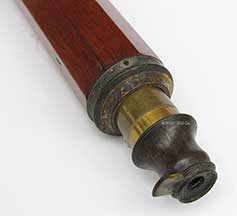 |
| closed | ocular |
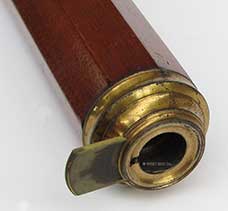 |
| objective |
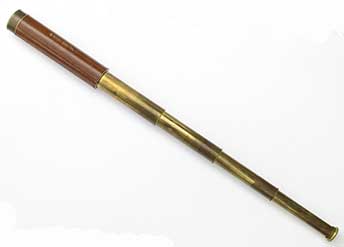 |
21. 59 TELESCOPE. Extra nice hand-held telescope from the early 1800’s. This unmarked 4-draw telescope is certainly of English manufacture. It has 1 ¾ inch achromatic objective lens in perfect condition, protected by its original press-on lens cover. Together with the original 4 element internal lens system it provides a highly magnified upright image of unparalleled clarity. Speaking to its age (circa 1830) it has the typical “flat” eyepiece with pivoting ocular dust slide characteristic of that era. This telescope is of all brass construction with leather covering which is in exceptionally fine, virtually mint condition. It measures 9 inches long closed and expands to an amazing 30 ¼ inches with a smooth tight action. They really don’t come any nicer than this! 795 |
 |
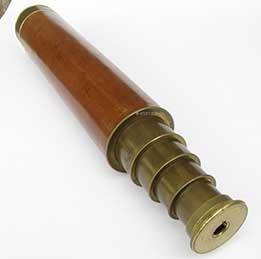 |
| closed | ocular |
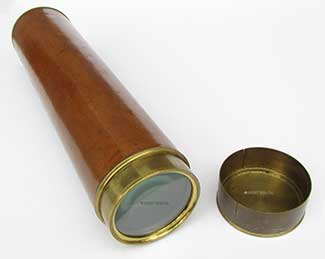 |
| objective |
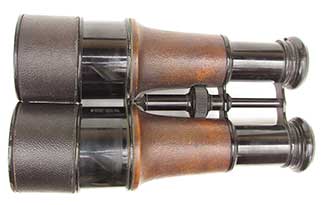 |
21.58 BINNOCULARS. Extra nice pair of 19th century French field binoculars. This high quality pair is signed on both of the oculars “L. PETIT FABT *PARIS*.” The set is of all brass construction with its original leather covering, Bakelite eyepieces and focusing knob. The oversize achromatic objective lenses measure an impressive 2 inches in diameter each and are in perfect original condition. Together with the internal lens system they produce a clear, stereoscopic image of about 6 x magnification. The focusing function is smooth and tight. This set is equipped with sliding sun shades which extend to an overall length of 9 inches. It compresses to 6 inches. Condition is absolutely immaculate for a pair of this age and configuration. The leather covering is excellent and the black lacquered brass surfaces are virtually pristine. SOLD |
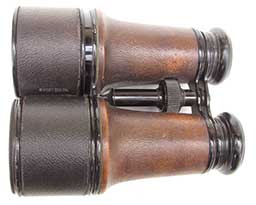 |
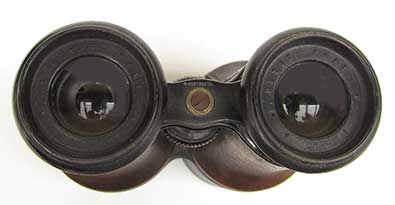 |
| closed | oculars |
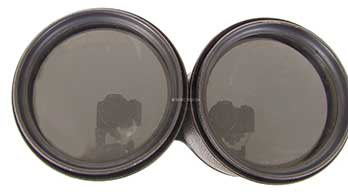 |
| objective |
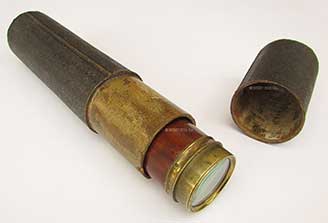 |
21.57 IMPORTANT TELESCOPE. Especially rare, early English telescope by the recognized 18th century English master instrument maker George Adams as finely engraved on the first draw “G. Adams * London*.” This classic 3-draw gentleman’s pocket telescope has a rich wooden mahogany barrel with fine brass fittings held by the very tiniest of screws. The eyepiece was of innovative form for its time having a pivoted shutter dust cover. The fist draw is etched to show its focusing position at infinity. Cleverly, the middle draw and the large tube have tiny holes to release pressure within when closing. The 1 ½ inch objective lens is Dollond’s achromatic patent. Together with the 4 element internal lens system it produces a highly magnified, clear image with no color distortion. The telescope measure 8 inches long closed and is 23 ½ inches long fully extended. What is particularly desirable about this early presentation is the existence of its original carrying tube which is fully covered in durable sharkskin. The foundation of the tube is turned wood! It measures 8 ½ inches in length and 1 17/8 inches in diameter and is in perfect condition. An incredible survivor of more than 250 years by a most important early maker! SOLD George Adams (1709-1773) began his scientific instrument manufacture at his residence on Shoe Lane, London in 1734. From 1738 to 1757 he worked at Tycho Brae’s Head, Corner of Racquet Court, Fleet Street, London. In 1750 he was awarded a patent for his telescope and in the same year received the Royal appointment of George III as Maker to the King. He is known to have produced and sold an array of scientific instruments including barometers, globes, microscopes, circumferentors, hygrometers, octants, opera glasses, planetaria, prisms, quadrants, rules, thermometers, sundials, and of course telescopes! (Gloria Clifton, “Directory of British Scientific Instrument Makers, 1550-1851,” 1995, The National maritime Museum, Philip Wilson Publishers, London.) |
 |
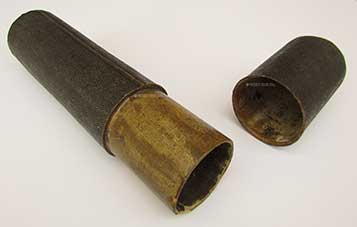 |
| case | case open |
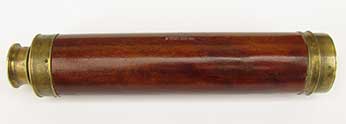 |
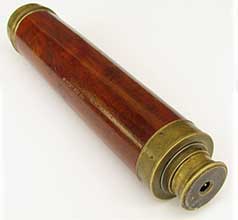 |
| closed | ocular |
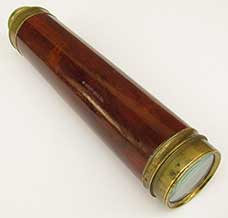 |
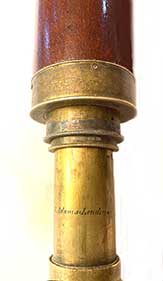 |
| objective | signature |
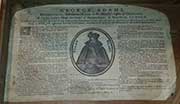 |
| trade card |
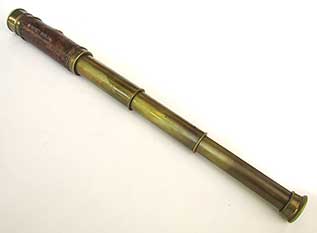 |
21.56 PRESENTATION TELESCOPE. Finest quality mid-1800s telescope by “E. G. WOOD, 74 Cheapside, London” as stamped on the objective lens cap. Then, as hand-engraved in cursive script is the presentation reading “7th S.V.R. Prize Meeting 1866 Presented by Mr. E.H. Hopkins Won by Private W. Roper.” This diminutive 3-draw gentleman’s telescope is all brass with leather covering the main barrel. The one inch doublet objective, along with the 4 original internal lenses, produces an image of surprisingly high magnification and extreme clarity. The telescope measures 5 ½ inches closed and 15 inches long fully extended. Functionally the condition is outstanding. Cosmetically, the leather covering is separated at the seam. Presentation telescopes of this size are quite rare! WAS $795 NOW! 249 Edward George Wood was a philosophical and mathematical instrument maker in London from 1833-1839. (Gloria Clifton, “Directory of British Scientific Instrument Makers 1550-1851,” 1995, The National Maritime Museum Greenwich.) With further research the nature of this presentation may be fully discovered. Likely it was an award given to a Private in the 7th S.V.R. (regiment) for outstanding performance. |
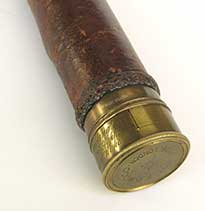 |
 |
| detail | reverse |
 |
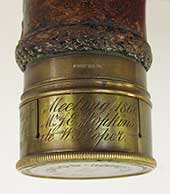 |
| closed | date |
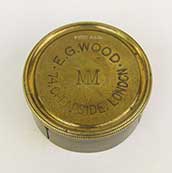 |
| maker |
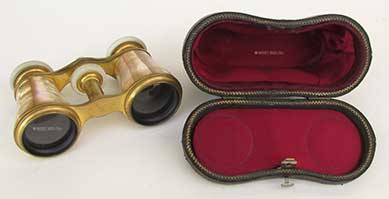 |
21.54 FRENCH OPERA GLASSES. Lovely pair of 19th century opera glasses by the noted makers “Lavista, Paris” as delicately engraved on each of the eyepieces. This high-quality optical device features twin tubes providing depth-of-field viewing superior to a telescope. They are totally encrusted in luminescent mother-of-pearl with gilded brass connectors. Even the draw tubes are adorned with tight sections of M.O.P! These provide a unique “deep” quality on their surfaces. The twin glasses focus with a smooth tight action activated by a knurled M.O.P. wheel at the center. This offering is complete in its black leather carrying case with purple satin lining. It is in remarkable, virtually pristine condition. The glasses themselves are in equally fine condition belying their century plus old origins. The glasses are 4 inches wide in sum, with each objective lens measuring 1 ¼ inches in diameter. Fully extended the set measures 3 1/8 inches long. The leather case is 4 ½ inches wide by 3 inches high and 2 inches thick. Amazingly the case still retains its original sturdy strap handle and original button snap closure. These are features rarely found in such outstanding condition! This set would make a treasured gift to a special loved one… at that, for a very reasonable price. 189 |
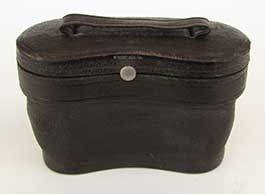 |
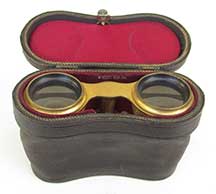 |
| case | in case |
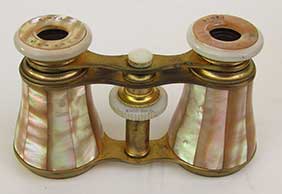 |
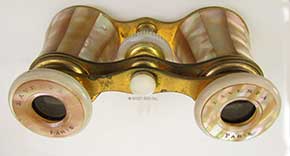 |
| glasses | oculars |
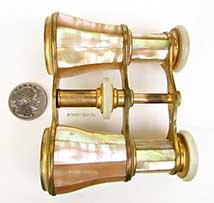 |
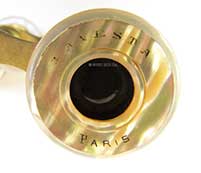 |
| extended | maker |
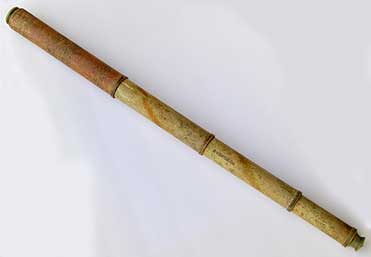 |
21.53 VERY EARLY TELESCOPE. Remarkable late 17th or very early 18th century telescope by the noted Italian inventor and optician “LEONARDO SEMITECOLO” as printed on the base of the main tube. This hand-held mariner’s telescope is constructed entirely of heavy vellum with turned horn fittings. The main barrel is beautifully embellished with floral and geometric designs. It expands with 3 draws to a focusing point of infinity marked on each of the draw tubes. The collars holding the tubes are turned bovine horn in near perfect condition. But even more remarkable, both the ocular and objective lenses still retain their original screw-on horn dust covers! The fact that these separate items are still together after more than 300 years is miraculous! The optics are entirely original and provide a magnified upright image. This telescope was manufactured long before Peter Dollond’s introduction of the achromatic lens in 1750, so the telltale “chromatic fringe” on the periphery of the image is present. This is a good indicator of age. What is most important is the state of preservation. Made after Galileo’s model, using delicate materials, this optical instrument is in amazing condition. 12 ½ inches closed extending to 34 ½ inches extended at infinity. Without a doubt museum quality of the first order. Price Request |
 |
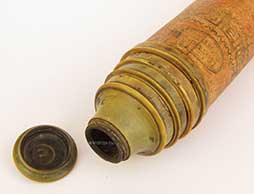 |
| closed | ocular |
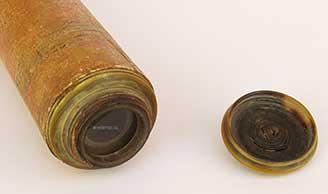 |
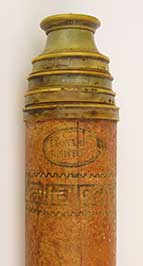 |
| objective | signature |
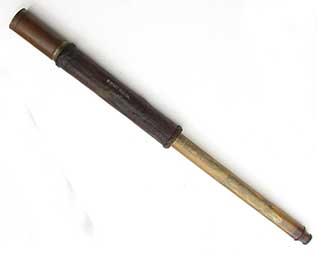 |
21.51 CAPTAIN's SPYGLASS. Extra nice turn-of-the-last century hand-held telescope by the famous Scottish makers "Dobbie McInnes. Ltd. GLASGOW. SOUTH SHIELEDS. LIVERPOOL & LONDON" as beautifully hand-engraved on the draw. This especially large telescope has a main barrel with a sailor-made sail canvas covering, hand-stitched and finished with handsome Turk's Head knots on each end. This form of Marlinspike seamanship is particularly desired by collectors. The single draw has an early style ocular with sliding dust cover. The objective is protected by a sun shade with sliding dust cover as well. Both slides operate properly. The original 5 element lens system is in perfect condition and provides a bright, highly magnified upright image of extreme clarity. 20 ½ inches long closed and 36 inches long fully extended without the sun shade. Excellent original condition. Approximately 120 years old. 949 The namesake of this nautical instrument company, Alexander Dobbie, established the firm in 1841. In 1881 it changed to Alexander Dobbie & Son. In 1902 the firm was incorporated as it appears here, Dobbie McInnes, Ltd. In 1914 the firm advertised itself as "Manufacturers and patentees of nautical and engineering equipment. In 1921 the name changed to Dobbie McInnes & Clyde, Ltd. Interestingly, this form of telescope remained unchanged from those made circa 1810 and later. At the time of its manufacture the magnification or "power" (times X) of early optical systems were not yet calculated. Suffice it to say this state-of-the-art telescope provides an amazingly clear, highly magnified image enhanced multiple times! |
 |
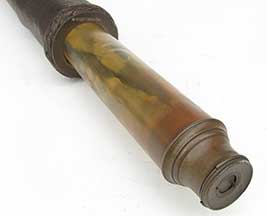 |
CLOSED |
OCULAR END |
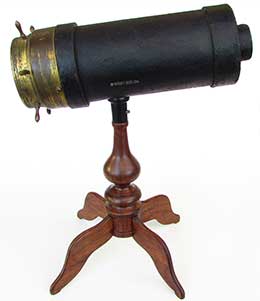
|
front |
front detail |
reverse |
eye piece |
image 1 |
image 2 |
maker |
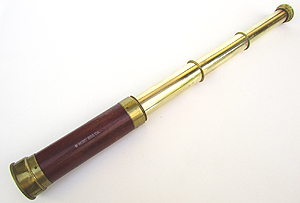
|
21.47 SUPERB TRAVELING TELESCOPE. Late 18th or very early 19th century gentleman's pocket compass made by the renown English instrument making firm of "Spencer Browning & Ruft, London" as hand engraved on the first draw. This delightful optical scientific instrument is made of wood and brass with 3 draws. The main barrel is rich mahogany with an achromatic objective lens measuring 1 3/8 inches in diameter. Remarkably this telescope retains its original press-on objective dust cover and its pivoting eyepiece dust cover both still in working condition! 6 ½ inches closed by 13 inches open. The original 4 piece internal lens system combines with the objective to provide a clear, highly magnified upright image free of chromatic distortion. Signed telescopes of this size by important makers are rare. The details of its construction are identical to its larger brothers 5 times bigger! The ultimate miniature for this size and age. 645 |
closed |
ocular |
objective |
signature |

|
21.40 DECORATIVE TELESCOPE by the MASTER. Very rare, particularly nice example of a late 18th century hand-held captain's spyglass by the inventor of the achromatic lens, Peter Dollond, as beautifully hand engraved in script on the first draw "Dollond Day or Night." What is most unusual about this handsome 3 draw telescope is the fact that it is decoratively painted with gilded floral scrolls on a green background on the main barrel. This is most unusual! The telescope has its traditional 4 element lens erecting system, which in combination with Dollond's signature achromatic objective lens, provide a clear, upright, highly magnified image free of color distortion. This telescope measures 35 inches long fully extended and 2 ½ inches in diameter. When closed it collapses to a mere 11 ½ inches. Excellent original condition in all respects. The old style nipple eyepiece retains its original dust slide. The objective cover is away. This is the first such decorated sea going spyglass we have encountered in our 40+ years! 975 |
closed |
decoration |
decoration reverse |
ocular |
objective |
signature |
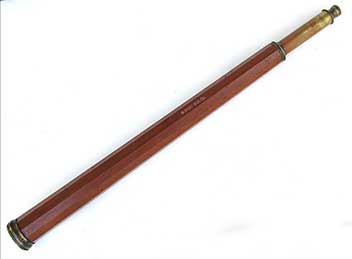
|
21.39 10-SIDED TELESCOPE. Particularly fine, very rare 10-sided telescope alternatively known as a "decahedral" telescope, from the 18th century. This early telescope, cutting edge for its time, was made by the well known English maker "HAMLIN London" as delicately hand-engraved on the draw tube. Unusual in design, this handsome scope has a large main body carved out of a single piece of solid mahogany tapered and faceted on 10 sides. The classic old fashioned brass objective collar is fitted with a sliding dust cover protecting the large achromatic lens. The ocular end is also of early design with a narrow nipple and sliding dust cover. In evidence of its early manufacture the draw tube pulls out without a stop. Of special note, is the fact that it contains 5 rather than the more common 4 internal lens elements. In consonance, this complex 6 element lens system produces a clear, highly magnified upright image without distortion. A remarkable accomplishment for the late 1700's! The telescope measures 26 inches long closed and 31 inches long extended to infinity. It is 2 ½ inches in diameter on the objective end. The draw itself measures 9 ¾ inches long. Exceptionally well-preserved condition considering an object like this is over 230 years old! Without a doubt museum quality in every sense of the word. SOLD |
closed |
draw |
ocular open |
objective slide |
objective open |
signature |
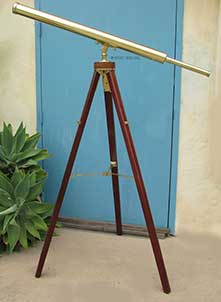
|
reverse |
draw tube |
eyepiese |
objective |
signature |
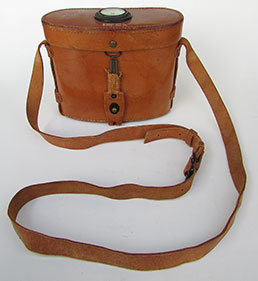
|
5.55 /21.90 EARLY NAVY BINOCULARS. Very scarce World War I vintage military binoculars made for the “Signal Corps U.S. Army” as stamped on the right side objective. On the ocular end it is marked “Military Stereo 6 x 30” on the left and “U.S. Naval Gun Factory Optical Shop Annex, Rochester, N.Y. U.S.A.” These high quality prismatic binoculars are made of solid brass in a blackened finish with leather covering. Each ocular is knurled for individual focusing and is marked in diopeters + or -. The binoculars retain their original leather carrying strap and are complete with their very nice heavy leather case with spring-loaded closure. Of added interest and value is the very high quality compass in the lid, showing the cardinal and intercardinal points of the compass marked in 5 degree increments. It is signed “U.S Naval Gun Factory Optical Annex, Rochester, N.Y.” The underside of the lid is impressed “U.S. NAVAL GUN FACTORY Optical Annex Shop Rochester, N.Y” with fouled anchor mark. The objective lenses measure 1 1/4 inches in diameter each. The binoculars are 6 ¼ inches wide and 4 ¾ inches long. The stout leather case is 7 ¼ inches wide by 5 ½ inches high. Excellent original optics and the compass is lively and accurate. The leather is in unusually nice condition considering it is over 100 years old. 495 |
case |
compass |
gun factory |
binoculars |
oculars |
objective |
maker |
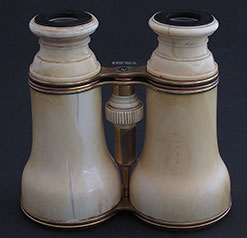
|
21.88. LARGE IVORY BINNOCULARS. A really incredible pair of 19th century binoculars with the bodies turned out of solid ivory! This handsome, super high quality optical instrument was obviously designed to be a cut above the usual instruments of its type with leather-covered brass bodies. Most likely of French manufacture this set exhibits the quality and craftsmanship indicative of French opticians in the 1800’s, as exhibited in this particularly difficult medium. The large twin objective lenses measure 2 ½ inches in diameter and are 5 inches wide overall. The gilt brass frames secure the lenses within the solid ivory bodies. Another set of gilt brass frames hold the oculars. Within each is a circular ebony eyepiece. The binoculars focus by turning a ribbed ivory knob in the center, extending from 4 5/8 inches closed to a full 6 1/8 inches. This action is very tight. The all original lenses combine to produce a stereoscope image of great clarity with good magnification and light gathering capability. Remarkably these old binoculars show relatively little cracking expected of such a medium about 150 years old. There is the obvious wear and age patina. The original satin-line leather carrying case is also in remarkable condition, complete with original carrying strap. The case measures 5 ½ by 5 by 3 inches and closes with a brass button latch. 895 |
in case |
oculars |
objectives |
top |
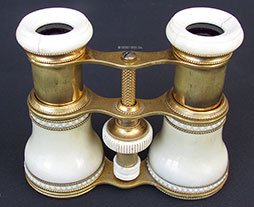
|
21.87 CASED BINOCULARS. Exquisite, highly finished 19th century binoculars/opera glasses made of solid ivory with gilt-washed brass fittings. Undoubtedly of French manufacture, this exceptional pair, befitting a queen, is of the highest order we have ever seen in our 40 years in this business. The brass and the ivory trim is magnificent. See is believing! The main body is of ivory inset with powerful lenses. The oculars are decoratively turned of solid ivory. It comes complete with a period leather case with hinged lid, in excellent condition. These binoculars measure 3 ½ by 4 ¼ inches wide. The objective lenses measure 1 ¼ inches in diameter. The stout fitted leather case is 5 1/8 inches wide by 5 inches high. Minor age checks do exist in the eyecups and some light wear to the rich gilding is apparent. Otherwise the entire presentation is perfect, including the all original optics which provide a clear upright image of high magnification with good light amplification. This is very rare offering. Check around before buying here. |
perspective |
detail |
bottom |
in case |
case |
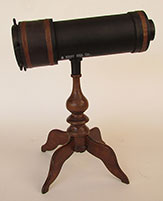
|
perspective 1 |
perspective 2 |
objective |
maker |
VIEW |

|
21.11 HISTORIC, VERY RARE PRESENTATION TELESCOPE! Without question the most significant presentation item we have offered in our 35+ years, involving the Queen of England and an American President! This classic two-draw mariner’s telescope is all brass with original optics, eyepiece and objective fittings, beautifully-engraved in fancy script on the draw near the eyepiece “Dollond, London, Day or Night” The eyepiece with original dust slide is of the early-form “nipple” type. The perfect 1 ¾ inch achromatic objective lens is protected by a press-fit lens cap with its own sliding dust cover. The body of the telescope is housed in a rich Moroccan leather covering in like new condition. The piece-de-resistance of this offering is the meticulously hand-engraved inscription on the sun shade barrel. It reads: Presented On behalf of ~ Queen Victoria ~ ~ by ~ JAMES BUCHANAN, ESQ. her Majestys Consul for NEW-YORK ~to~ ~Mr. SAMUEL RICH~ First Officer of the Packet Ship Rhone JAMES WOTTEN ESQr COMMANDER as an acknowledgement of his humane Efforts in rescuing from Death ~CAPTAIN McNICOLL~ and ten of the crew of the British Barque Belinda of TROON Upon the 22nd day of November ~ 1840~ The inscription is clear, deep and untouched. The surrounding brass has acquired a rich statuary bronze patina that does not appear to have been polished or cleaned since its inception 179 years ago! The telescope itself is in an amazing state of preservation and is fully functional providing a highly magnified upright image of great clarity. The draws pull in and out with a smooth, tight fit. It measures 15 inches closed by 2 ½ inches in diameter and extends to 38 ½ inches long. Without a doubt this exquisite lifesaving relic would find a prominent place in any major American or British Museum. 6295 Buchanan was born in Pennsylvania and became a prominent lawyer in the town of Lancaster. He was first elected to the Pennsylvania House of Representatives in 1820 and later won a seat in the United States House of Representatives, aligned with Andrew Jackson's Democratic Party. President Jackson appointed him Minister to Russia. It was during that time he made this presentation on behalf of Queen Victoria. Soon after, Buchanan was elected senator of Pennsylvania. In 1845, he accepted President James K. Polk's appointment as Secretary of State. While in that position, the land mass of the United States grew tremendously with the addition of the Oregon Territory and annexation of the Southwest as a result of the Mexican War. From 1853 to 1856, during the presidency of Franklin Pierce (1853 – 1856) Buchanan served as the United States’ Ambassador to Britain. Buchanan won his party's Presidential nomination in 1856, defeating Pierce and Senator Stephen Douglas at the 1856 Democratic National Convention. He went on to become President, defeating Fremont and Fillmore in the 1856 election. He was succeeded by Abraham Lincoln in 1860. |
extended |
ocular |
objective dust slide |
objective cover |
inscription 1 |
inscription 2 |
maker |
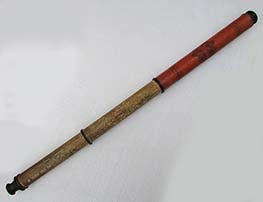
|
21.07 17th CENTURY TELESCOPE. Very rare, late 17th or very early 18th century mariner’s telescope in the Galileo style by the Italian master Leonardo Semiticolo as impressed on the ocular end of the main barrel. This 2-draw telescope is made of paper and vellum with turned horn eye pieces, sections and ends. Its clever construction makes for a very lightweight instrument manageable with a single hand. The red orange barrel is decorated with recurring geometric, floral and bead-like designs. The 2 draws are greenish yellow with a mottled surface. Both are marked with concentric rings indicating the position of distention for infinity. The eye piece of turned horn is of the early “nipple” form retaining its original screw-on dust cap. Remarkably, the objective also retains it original dust cover. This is absolutely amazing after more than 300 years! The telescope measures 28 inches long fully extended and compresses to 12 ½ inches closed. The original optics provide a surprisingly clear, highly magnified image with the expected chromatic aberration characteristic of pre-1750 telescopes. Excellent condition in all respects. A true museum piece. Price Request |
The technology of lens making and the grinding of optical glass was in its infancy at the time this telescope was made. Glass without occlusions was hard to make. Accordingly lens makers reverted to small, thin glass lenses which could be enhanced by increasing their focal length. The result was the characteristic long telescope barrel with a very small objective lens. But Peter Dollond's patent of the achromatic lens in 1758 changed telescope manufacturing for the ages.
CLOSED |
OBJECTIVE |
OCULAR |
SIGNATURE |
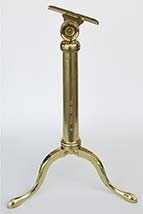
|
21.06 TELESCOPE TRIPOD. Genuine early 19th century table tripod for a premium quality library telescope of the period. This authentic, heavy solid brass tripod is of English origin with lovely Queen Anne cabriolet tripod legs which support a gradually tapered strut. This strut supports the telescope mount at the top. The mount is fully articulated with train and elevation functions which are smooth and tight with no play – as required of such a quality instrument. 24 ½ inches long overall. 19 inches tall as configured. The footprint is 14 ¼ inches on the three legs. Weight 8 pounds. Outstanding original condition in a high polished brass finish with preservation coating. Guaranteed to be over 100 years old. 695 |
DETAIL |
FOLDED |
TRIPOD |

|
21.04 ANTIQUE TELESCOPE. Very scarce octagonal barrel captain’s spyglass dating from the early 18th century. It is a genuine relic from the early days of sail made in England which features a long 8-side barrel carved from a single piece of rich mahogany. This old sea veteran has several distinctive features which reveal its great age. It has the early form reverse taper characteristic of telescopes manufactured from the 1680's. The objective end with traditional brass collar has a sliding lens cover housing its single piece objective lens measuring only 7/8ths inches in diameter! The draw tube contains only three (not the usual 4) erecting lenses. These single element lenses are held in by threaded retainers, not rolled in as with later 18th and 19th century telescopes. The ocular consists of a later knurled brass eye cup with built-in pivoting dust cover. Another early aspect is the fact that the draw tube slides in and out of the barrel freely with no stop. In combination the all original lens system provides a magnified image with the telltale “chromatic fringe” characteristic of the earliest telescopes. Cosmetically it is in outstanding original condition with no dents cracks or other flaws – just great old age. 25 inches long closed and 30 ½ inches long extended. A beautiful example approximately 300 years old. Certainly a museum piece! Price Request The technology of lens making and the grinding of optical glass was in its infancy at the time this telescope was made. Glass, without occlusions was hard to make. Accordingly, lens makers reverted to small, thin glass lenses which could be enhanced by increasing their focal lenth. The result was the charateristic long telesope barrel with very small objective lens. But Peter Dollond's patent of the achromatic lens in 1758 changed telescope manufacturing for the ages. |
draw |
draw 2 |
objective |
objective end |
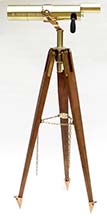
|
21.03 U.S. NAVY TRIPOD TELESCOPE. Absolutely the ultimate in U.S. Naval optics, this is a pre-World War II vintage flag bridge telescope. A precious few such telescopes were also configured for exploratory landing party use and were mounted to their rarely found U.S. Navy terrestrial tripods.. Because of the stresses and abuse that such arduous use inflicted, few survived. Represented here is a very scarce original example in virtually perfect condition in all respects! Made of heavy solid brass this telescope has the finest state-of-the-art optics of its time produced by the highly respected Bausch & Lomb Optical Co. as marked on the silver maker’s plaque on top of the barrel: “SHIP’s TELESCOPE Mk I MOD. BU. SHIP’S U.S. NAVY (N) 255, 1940 B & L OPT CO.” The barrel has two sighting pins mounted on top and a built-in sun shade protecting the 3 inch objective lens. A large handle is attached to the left side for conveniently training and elevating. A set of internal rotating filters are provided for maximum clarity in sunlit, hazy or low light conditions. They are selected by means of a knurled brass knob just below the eyepiece. The ocular provides a 28X image of exceptional clarity and brightness. Of immense added value and versatility, there are an additional 4 interchangeable eyepieces of 12, 14, 22 and 32 powers! Focusing is accomplished by turning the knurled adjustment ring with a range of -4 to +2 diopters in ¼ increments. The telescope body is supported by its extremely heavy thick bronze collar with trunnions suspended in the equally heavy solid bronze yoke. Removal of the telescope when not in use is made by loosening the hinged trunnion caps with knurled locking lugs. The yoke has a stout bronze support spindle which fits snugly into the tripod “spider,” complete with bearing and even a zerk grease fitting! The end of the spindle is finished off with an extra large brass cap nut. The yoke bears a silver maker’s tag reading, “MOUNT For SHIP’s TELESCOPE Mk I Mod. BU. SHIP’S 1940 B & L OPT. CO.” the spider is also solid bronze and is marked in high relief “U.S. NAVY Tripod model 660 U.S. Metal Products Co., New York.” A brass collar fits over the spindle allowing the height of eye to be raised or lowered by 5 inches. The high quality tripod legs, made of finest hardwood maple have all brass fittings and are tipped with bronze “feet.” A central brass chain allows for splaying the legs to different widths. This feature allows for further height adjustment and stability. The legs are detachable from the spider by means of large brass butterfly wing nuts. The barrel of the telescope measures 28 ½ inches long as pictured with protective screw-on ocular cover. The barrel is 4 ¾ inches in diameter. The entire assembly stands 64 ½ inches tall as shown. This measurement is with the 5 inch height adjusting collar inserted. The footprint of the tripod as shown is 29 inches between each leg. The condition, both cosmetically and functionally of the entire unit is nothing short of spectacular -- particularly in light of the fact it is over 75 years old! At the time of its manufacture, this unit cost the Government more than the price of a car. |
TELESCOPE |
REVERSE |
TOP VIEW |
OCULAR |
OBJECTIVE |
MOUNT |
MAKER |
SPIDER |
SPIDER REVERSE |
EYE PIECES |
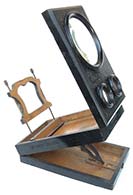
|
21.79 EXTRA FANCY VICTORIAN ERA STEREO VIEWER AND MAGNIFIER. This beautiful, high quality optical instrument is as decorative as it is functional. It consists of three-tiers of ebonized hardwood profusely engraved with floral decorations embellish in gold. On the top front is a large monocular lens for viewing photographs in detail. Below it a pair of oculars are for viewing stereo cards. A height-adjustable pierced wooden support mounted on two brass rods is provided for holding a card or photo. It is also adjustable for depth, sliding back and forward in grooves on each side. The front of this viewer is hinged with a brass “stay” on the right to lock it in the upright viewing position. When not in use it folds closed on a friction latch. The bottom tier is equipped with a wooden track and folding arm which allows the viewer to be inclined to one of three preset angles. The front bears the oval brass maker’s plaque reading “76 .UNIS . FRANCE 3 STEREOSCOPES - PARIS” 10 ½ inches long by 6 ¾ inches wide and 3 inches thick when closed, elevating to a working height of 16 ¾ inches. Superb original condition. 1395 |
CLOSED |
BASE |
FRONT |
IMAGE |
STEREO CARD |
CARDS ONE |
CARDS TWO |
MAKER |
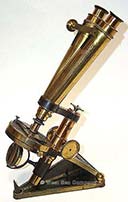
|
21.4 BINOCULAR MICROSCOPE. High grade 19th C. English microscope made for the American market, signed and serial numbered on the base "R. & J. Beck, London 7072." and further engraved on the main tube "J W QUEEN & Co. Agents, Philadelphia & New York." This finely crafted all brass compound microscope features adjustable Wenham-style binocular body tubes mounted on a sturdy base and stands 14 inches tall as shown. It is complete with a total of 4 objectives and 4 ocular lenses. It is housed in a lovely African mahogany box with brass furniture measuring 16 inches long. The lower till houses numerous glass slides while the upper section holds the additional optics, with 11 slots being empty including a separate slot for a light magnifier which is also missing. Of course the beauty of the innovation embodied in this microscope was the fact that the researcher could view a particular object with both eyes providing a clearer stereoscopic subject. This rare instrument is in excellent, untouched original condition with most of its original lacquered surfaces. It is functional and all adjustments operate smoothly and properly. A most handsome presentation! 2195 |
WITH ACCESSORIES |
BOX |


